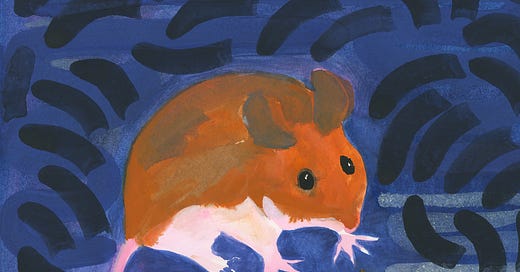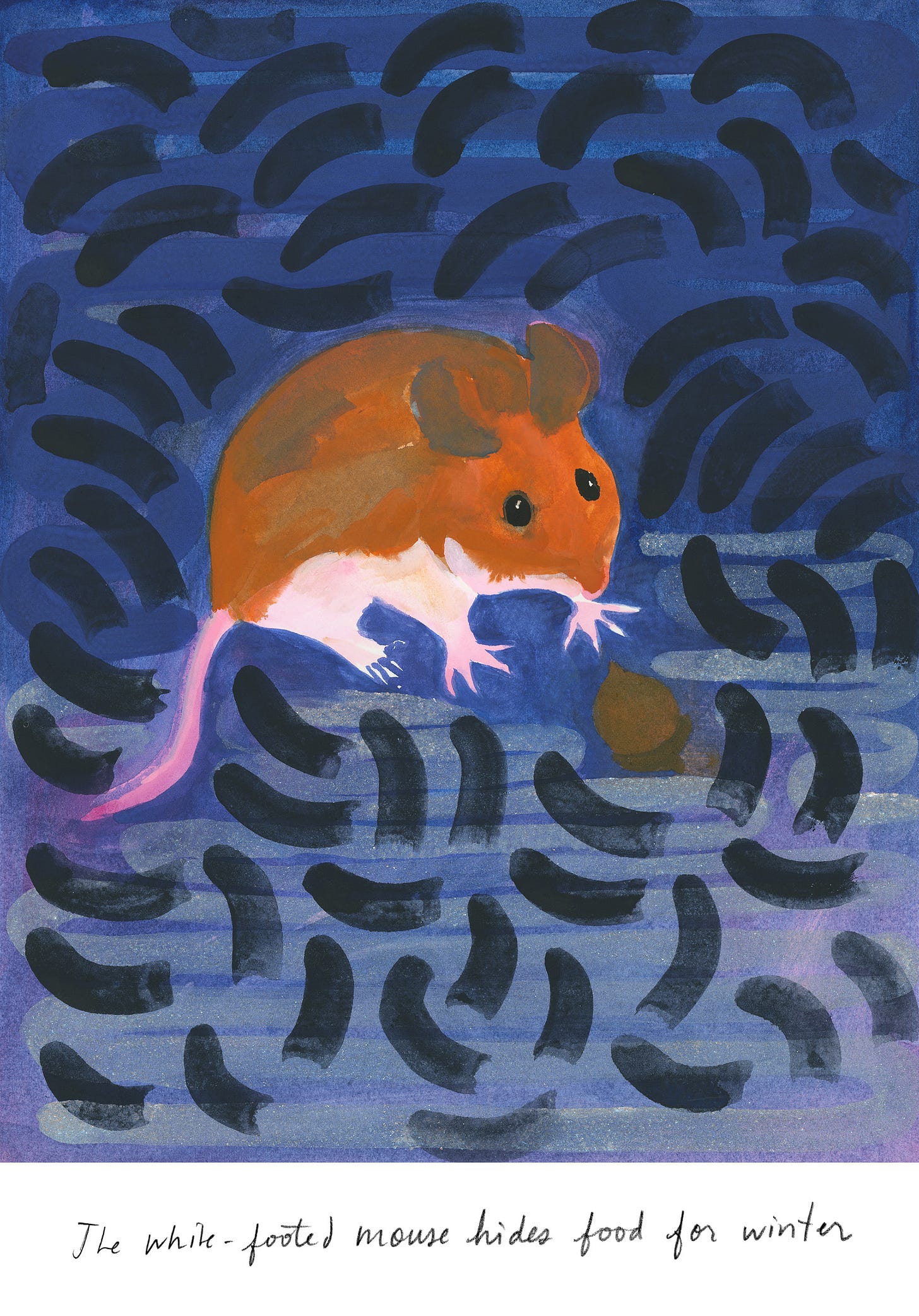Hi, friends — I decided to begin the year with the small heartbeat of a rodent. There’s something compelling about rodents, living their lives under our noses, daring and inscrutable. As always, please send in your mice stories or add them to the comments (any mouse species is fine; I have many house mouse stories, mainly involving chocolate, and perhaps you do, too). — Amy Jean
I once caught a white-footed mouse in a bubble envelope. The mouse had gotten itself cornered in a basement storage area at work. I grabbed a nearby bubble envelope (9 x 12 in.) and scooped it in. It happened fast, and I'm not entirely sure how to explain the scooping part (i.e., I would not be able to advise on this particular method of catching mice).
I carried the mouse in the bubble envelope through the office, gesturing as if it were a normal thing to have a mouse in a bubble envelope. (“Nice weather, eh? Yeah, I’ve got a mouse in here. Okay, see you later.”) I took the mouse outside and walked to some trees, crouched down to the ground and slowly opened the envelope. The mouse paused for a second and then took off, no bother, into the leaf litter. (In an alternate reality I mailed the mouse, and it traveled the world with many adventures in a fine suit of clothes.)
The white-footed mouse (Peromyscus leucopus) is related to the house mouse, which is likely the one you know well, the one snooping in your walls, the one that has most effectively adapted to humans. White-footed mice will also cozy up in your garage or basement, or possibly the air filter of your car (this happened to us once and a mouse sprung out of the glove compartment at soccer practice—a total shock for everyone involved), but, in general, white-footed mice are timid and would rather avoid people.
White-footed mice are mainly solitary creatures and occupy home ranges of about an acre or so. A male’s territory overlaps with many females, so a dozen mice might live in the same area. I like to think of their small territories overlapping across North America—if you could make an aerial map of them, what kind of patchwork abstraction would they create? Also, I wonder, does every human home come with a halo of mice?
Life happens fast when you're small and near the bottom of the food chain. White-footed mice live for about a year in the wild and reproduce quickly, so an area might turn over an entire new set of mice each year. Mother mice are nurturing and protective of their tiny babies, and males will sometimes help, too.
White-footed mice do not hibernate (part of the reason why they might look for warmth around your home). Instead they stay in their nests, filled with food from their industrious autumn foraging. They will enter a state of torpor (a deep sleep) during cold spells. On warmer nights, they might venture out to their many food caches. I once found a trove of dried fruit snacks in a tree hollow about five feet off the ground (white-footed mice are great climbers).
They are omnivorous and eat all manner of acorns, seeds, grasses, berries, mushrooms, and insects, including the gypsy moth caterpillar (which, thank goodness). Their foraging and dispersal of seeds and spores is beneficial to their ecosystem. On the flip side, white-footed mice are an important food source for nocturnal predators like red foxes and great horned owls, skunks, bobcats, and coyotes, to name a few. Unfortunately, they are also a favorite host of deer ticks, which means they are a vector for Lyme disease (and so the cycle of predation is not only important for the predators, but for us, keeping their numbers in check.)
White-footed mice have large eyes that are well-suited to seeing in the dark. They have keen senses of hearing and smell, and their sensitive whiskers guide them, too. Apparently they are rather chatty, but their vocalizations are ultrasonic and beyond our perception. We can, however, hear their drumming—my very favorite behavior of white-footed mice is a mystery. No one knows why exactly, but white-footed mice will drum on dry leaves and other materials with a front paw, making a fast buzzing sound.
The mouse in the bubble envelope was the closest I’ve ever been to a live wild mouse. Peering in I could see its bright eyes and twitching whiskers, its perfect small paws and ruddy fur; the pale pink of its nose and ears. For those few strange minutes our worlds collided unwittingly around a bubble envelope. After its release, the mouse went back to its relatively unknown, parallel world. And, I suppose, I did, too—I went back to the office.
Mice links—
If you have 1:34 mins, you might watch this video of a white-footed mouse sniffing the air in Central Park.
Or you might like this 30-sec. video of a white-footed mouse drumming (in this case, on a garbage bag).
The Alston’s singing mouse in Central America is known to sing and seems to have conversations, too. Their patterns of vocalizations may offer clues to the origin of human language. [The Independent]
Speaking of mice in fine clothes: Beatrix Potter originally wanted to be a scientist (look at these gorgeous mushroom drawings via BrainPickings) but realized she would have greater success and make a far bigger impact creating stories for children (which of course she did). Her picture-book drawings are as closely observed as her scientific illustrations. Here is Hunca Munca and Tom Thumb from Two Bad Mice, via Project Gutenberg.
Animal encounters in recent comments—
Reindeer sightings in the Yukon! Thank you, Susan!
A red fox in the old stomping trails of teenagers
Plus, a friend sent this link of an opossum shoving a skunk into a pond (a good one if you’re feeling grumpy).
Also—
Next week: the clever, sometimes infuriating American crow. I’d love to hear your suggestions for animals, too.
My white-footed mouse drawing is for sale; please reply if you’re interested.
Please forward to friends who might enjoy. This newsletter is a small weekly adventure about the life around us.






I have a great many mouse stories. Unfortunately, very few of them are about cute creatures and a happy ending. Three, though, anyway: in the late 1950s I was a lieutenant in the British army briefly (national service) and I killed so many mice (sorry) in my bedroom of the officers' mess that I was voted Rodent Officer of the barracks. More recently, when I cleaned out one of many bird boxes for the winter, a family of mice jumped out at me, clambering over my neck and shoulders and one disappearing down my shirt. Between these two memories was a job incident. I was on the phone interviewing someone who had applied to be my assistant. We were both at home and I was in flip-flops. A mouse was walking across the room towards me. I described the situation to the interviewee right up to the moment when it came in range of my feet. The end.
I had no idea mice would eat chocolate. I always assumed their tastes ran to the savory. In my defense—cheese in traps a pizza rat reinforced this assumption.
And the drumming. Oh my heart. Maybe they’re having a little mousy drum circle.